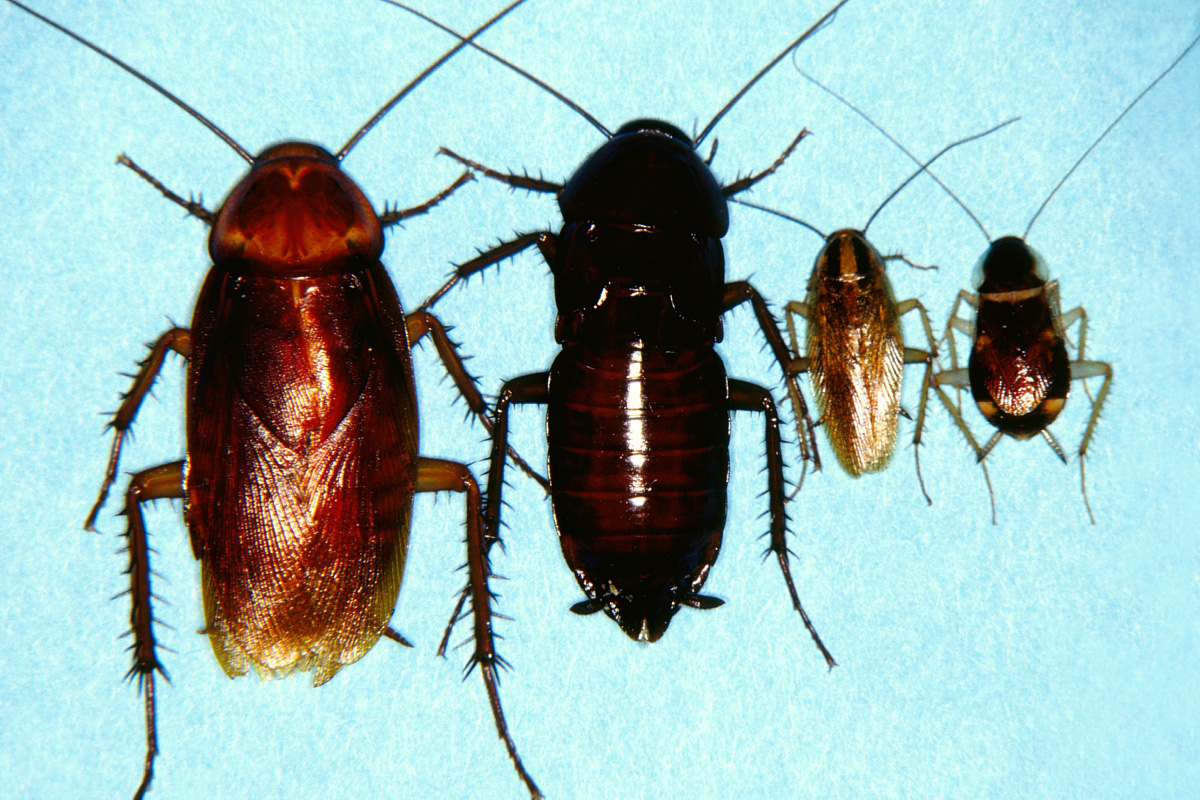
By Jody Green, Extension Educator
Cockroaches are one of the most recognized and unwanted home invaders. They are oval shaped with long, thread-like antennae and running legs. Cockroaches are thigmotatic, meaning they prefer to hide in tight places. They prefer darkness, hiding and breeding in cracks and crevices.
Cockroaches are omnivorous and feed on organic waste such as food scraps, starches, pet food and garbage. Cockroaches transfer bacteria that cause infections including salmonellosis and gastroenteritis. Their saliva, exoskeleton and feces are responsible for childhood allergies and can trigger asthma.
COCKROACH LIFE CYCLE
Cockroaches undergo incomplete metamorphosis where immature forms are smaller, wingless versions of the adult. Adult roaches may or may not have wings — but regardless, most do not fly. Adult females produce egg capsules called ootheca, from which multiple offspring emerge and the reason roaches have such a high reproductive capability. Cockroaches must molt and shed their exoskeleton to grow and develop. Sometimes homeowners report white or albino roaches. These are newly-molted cockroaches and will harden, darken and look like other roaches after a few hours.
INDOOR COCKROACHES
German roach — The most common cockroach of kitchens is the German cockroach. They are located throughout the United States and the world. They are found in warm, moist environments like kitchens and bathrooms, especially in multi-family housing where they travel easily between units using pipe chases and shared walls. They can also hitchhike into new locations in packaging (especially cardboard), infested items and personal bags. German roaches are usually discovered when residents turn on a kitchen light in the middle of the night to a rapid scattering on the countertop. They are generalist feeders and will feed on almost anything, such as food stuffs, crumbs, starches, fabric and trash. They will hide in cabinets, drawers and appliances. Where they harbor (seek shelter), they will leave fecal stains. German cockroach adults are approximately 1/2-inch long, light brown with two dark, longitudinal bands on the pronotum (behind their head). They have fully formed wings, but do not fly. Nymphs are wingless and have dark longitudinal stripes extending the length of the abdomen. Females can be seen carrying around the ootheca, which extends from the abdomen under the wings and carried until it is ready to hatch. The German cockroach breeds throughout the year indoors. Without food or water, adults will die within two weeks.
American roach — American roaches are called “Palmetto bugs” in the southern states. They are associated with old buildings with connecting basements, storm sewers and steam tunnels because they like temperatures over 80°F and high moisture. They are 1-1/2-inches long, reddish-brown, with a dark “M” on pronotum. Adults have thick, full-length wings, but they do not fly in Nebraska. Females drop their ootheca in hidden areas such as crevices, wood piles or basement perimeters. American cockroaches feed on a variety of foods including decaying organic matter, starches and sweets. They can survive up to three months without food, but only a month without water.
Oriental roach — Oriental cockroaches are called “water bugs” in Nebraska because they are highly associated with water. They live in cool, dark, damp places such as laundry rooms, basements and sump rooms with floor drains. They feed on decaying organic matter and filth. Sometimes populations of Oriental cockroaches live outdoors near the foundation under the slab, yards, dumps, crawlspaces and retaining walls. Adults are approximately 1 to 1-1/4-inches long, with a uniform shiny, black body and pronotum. As nymphs, they are a light brown color and may be confused as American roaches. Males have 3/4-length wings and females are wingless, but neither are able to fly. Females glue or hide their ootheca in debris in warm, sheltered locations. Oriental cockroaches can live for a month without food, but only two weeks without water.
GENERAL MANAGEMENT
Sanitation — To limit population growth indoors: Reduce available food and water sources. For example, clean up spills, fix leaky sinks, manage trash and compost, and store food products in air-tight containers. To reduce conducive conditions for the American or Oriental cockroaches which may come in from outside: Remove leaf litter, fix drainage issues, trim vegetation, manage mulch, and clean out window wells and gutters.
Exclusion — Stop cockroaches before they can enter the home. This includes caulking and sealing gaps around utility pipes, filling holes in the floors and walls, and screening floor drains.
Prevention — Inspect items coming into the residence, especially if coming from a location with a known cockroach infestation. Discard corrugated cardboard used to transport items.
Trapping — Use of glue boards can help monitor for cockroaches, determine population size and locate harborage areas. Younger nymphs do not travel far from the harborage. Adults do. Sticky traps can help evaluate the treatment program to make sure the number of cockroaches decrease over time. Vacuuming can also reduce the population and reduce the cockroach allergens in the residence.
Insecticides — Cockroach-specific bait can control cockroaches and are a least toxic alternative to spraying indoors. Residual insecticide sprays are not recommended for German cockroaches due to the proximity of this pest to food items, dishes, utensils and countertops. Cockroach baiting programs are very successful at reducing cockroach infestations, however some infestations may warrant an exterior perimeter treatment with spray, dust or granular bait. Professional companies strategically choose and apply baits based on the specific cockroach and are recommended for large infestations. There are several available bait stations sold in stores for homeowners. Be sure to read and follow the label, choose one appropriate for the size of cockroach and install as close to harborage area as possible.
FOR MORE INFORMATION
A longer version of this article with information about brownbanded and wood cockroaches is online at https://lancaster.unl.edu/pest/resources/cockroachmanagement.shtml